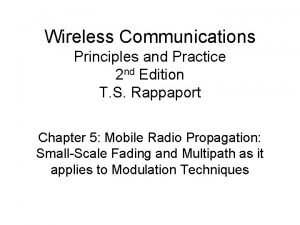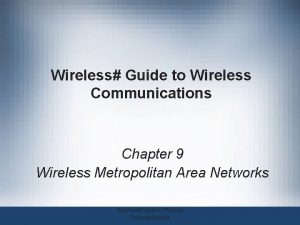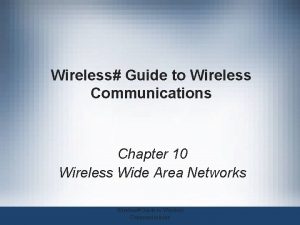WIRELESS COMMUNICATIONS Assist Prof Dr Nuray At The




















- Slides: 20

WIRELESS COMMUNICATIONS Assist. Prof. Dr. Nuray At

The Three Basic Propagation Mechanisms 2 Diffraction Occurs when the radio path between the T-R is obstructed by a surface that has sharp irregularities (edges). ü Diffraction allows radio signals to propagate around the curved surface of the earth, beyond the horizon, and to propagate behind obstructions. ü Diffraction field has often sufficient strength to produce a useful signal. Fresnel Zone Geometry Obstructing screen is placed between T-R at a distance d 1 from the transmitter and d 2 from the receiver h: effective height

The Three Basic Propagation Mechanisms 3 Knife-edge diffraction geometry Equivalent knife-edge geometry Assume that and The excess path length, the difference between the direct path and the diffracted path: The corresponding phase difference is

The Three Basic Propagation Mechanisms • 4

The Three Basic Propagation Mechanisms The electric field strength, Ed, of a knife edge diffracted wave The diffraction gain: An approximate solution provided by Lee is Hwk: Plot both the diffraction gain and its approximate solution by Lee. 5

The Three Basic Propagation Mechanisms Knife-edge diffraction gain 6

The Three Basic Propagation Mechanisms Example: Given the following geometry, determine a. The loss due to knife-edge diffraction b. The height of the obstacle required to induce 6 d. B diffraction loss. Assume f = 900 MHz. Knife edge T 100 m 50 m R 25 m 10 km 2 km 7

The Three Basic Propagation Mechanisms • 8

The Three Basic Propagation Mechanisms • 9

Link Budget Design Using Path Loss Models 10 Most radio propagation models are derived using a combination of analytical and emprical methods. Log-distance Path Loss Model Both theoretical and measurement-based propagation models indicate that average received signal power decreases logarithmically with distance, whether in outdoor or indoor radio channels. Ø The average large-scale path loss for an arbitrary T-R separation or where n is the path loss exponent, d 0 is the close-in reference distance.

Link Budget Design Using Path Loss Models v The value of a path loss exponent n depends on the specific propagation environment. Typical path loss exponents Environment Path Loss Exponent, n Free space 2 Urban area cellular radio 2. 7 to 3. 5 Shadowed urban cellular radio 3 to 5 In building line-of-sight 1. 6 to 1. 8 Obstructed in building 4 to 6 Obstructed in factories 2 to 3 11

Link Budget Design Using Path Loss Models • 12

Link Budget Design Using Path Loss Models • 13

Link Budget Design Using Path Loss Models • 14

Link Budget Design Using Path Loss Models By choosing the signal level such that where 15

Link Budget Design Using Path Loss Models 16 Example: Four received power measurements were taken at distances of 100 m, 200 m, 1 km, and 3 km from a transmitter. Let d 0 = 100 m. Assuming the log-normal shadowing path loss model, a. Find the minimum mean square error (MMSE) estimate for the path loss exponent, n. b. Calculate the standard deviation about the mean value. c. Estimate the received power at d = 2 km using the resulting model. Distance from Transmitter Received Power 100 m 0 d. Bm 200 m -20 d. Bm 1000 m -35 d. Bm 3000 m -70 d. Bm

Small-Scale Multipath Propagation 17 Ø In built-up urban areas, fading occurs because the height of the mobile antennas are well below the height of surrounding structures. Ø The incoming radio waves arrive from different directions with different propagation delays. Ø The signal received by the mobile at any point in space may consist of a large number of plane waves having randomly distributed amplitudes, phases and angles of arrival. Ø These multipath components combine vectorially at the receiver antenna, and can cause the signal received by the mobile to distort or fade. Ø Even when a mobile receiver is stationary, the received signal may fade due to movement of surrounding objects in the radio channel.

Small-Scale Multipath Propagation The three most important small-scale fading effects: ü Rapid changes in signal strength over a small travel distance or time interval ü Random frequency modulation due to varying Doppler shifts on different multipath signals ü Time dispersion (echoes) caused by multipath propagation delays. 18

Small-Scale Multipath Propagation 19 The Doppler Shift Ø Due to the relative motion between the mobile and the base station, each multipath wave experiences an apparent shift in frequency. The shift in received signal frequency due to motion is called the Doppler shift. Consider a mobile moving at a constant velocity v, along a path segment having length d between points X and Y, while it receives signals from a remote source S. The difference in path lengths

Small-Scale Multipath Propagation 20 The phase change in the received signal due to the difference in path lengths The apparent change in frequency, or Doppler shift fd: ü If the mobile is moving toward the direction of arrival of the wave, the Doppler shift is positive (i. e. , the apparent received frequency is increased) ü If the mobile is moving away from the direction of arrival of the wave, the Doppler shift is negative (i. e. , the apparent received frequency is decreased)
 Nuray haliloğlu
Nuray haliloğlu Arzu nuray
Arzu nuray Nuray isla
Nuray isla Nuray at
Nuray at Nuray çolapkulu
Nuray çolapkulu Telecommunications the internet and wireless technology
Telecommunications the internet and wireless technology Guide to wireless communications 4th edition
Guide to wireless communications 4th edition Wireless personal communications
Wireless personal communications Andrea goldsmith wireless communications
Andrea goldsmith wireless communications David tse fundamentals of wireless communication
David tse fundamentals of wireless communication Subsea wireless communications
Subsea wireless communications Guide to wireless communications
Guide to wireless communications Theodore s rappaport wireless communications
Theodore s rappaport wireless communications Sircim
Sircim Intelligent assist device
Intelligent assist device Assist electrical
Assist electrical Cisco smart assist
Cisco smart assist Cisco smart assist
Cisco smart assist Plan esmeralda premium colmedica
Plan esmeralda premium colmedica Travel guard ez tips
Travel guard ez tips Missionassist
Missionassist





































